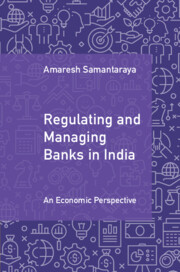Book contents
- Frontmatter
- Contents
- List of Figures
- List of Tables
- List of Boxes
- Acknowledgements
- List of Abbreviations
- Prologue
- Part I Introduction to Banking in India
- Part II Banks and the Economy
- Part III Banking Risks, Regulations and Risk Management
- Part IV Managing the Banking Business
- Part V Performance of Banks in India and Contemporary Issues
- References
- Index
7 - Banking Regulations and Supervision: A Broad Overview of Different Forms and Manifestations
Published online by Cambridge University Press: 28 February 2025
- Frontmatter
- Contents
- List of Figures
- List of Tables
- List of Boxes
- Acknowledgements
- List of Abbreviations
- Prologue
- Part I Introduction to Banking in India
- Part II Banks and the Economy
- Part III Banking Risks, Regulations and Risk Management
- Part IV Managing the Banking Business
- Part V Performance of Banks in India and Contemporary Issues
- References
- Index
Summary
Learning Objectives
• To undertake a broad overview of banking regulatory policies towards managing banking risks and reducing the scope of bank failures
• To outline the contours of banking regulatory policies in India in a historical perspective
• To provide details on the adoption in India of the Basel prudential norms on capital adequacy which emerged as the mainstay of banking regulatory policies linking risk embodied in the banking business to minimum capital adequacy requirements
• To provide an outline of the banking supervision procedures of the RBI
7.1 Introduction
In Chapter 6, we identified various types of risks involved in the banking business and their underlying causes. Based on this we underscored the rationale for banking regulation and supervision to contain banking risks. Healthy and vibrant banks facilitate economic progress as explained in the previous chapters. Insolvency of banks and liquidity problems, on the other hand, can severely disrupt real economic activities. Guided by these reasons, banking regulation and supervision are widely treated as the central pillars of public policy across countries towards promoting the safety and soundness of banks. Banking regulations fundamentally strive to follow the twin objectives of (a) maintaining the stability of the banking system and (b) protecting the interest of bank depositors and borrowers.
The emergence of different kinds of banking risks historically and measures to address them have an analogy with human ailments causing fever and their treatment in medical science. When people suffered from low-grade fever caused by the common flu or cold, paracetamol was invented to treat the same. Subsequently, a new variety of fever known as malaria caused by mosquito bites became a major health concern. Medical research invented chloroquine to treat malaria. Typhoid, traced to infection that spreads through contaminated water and food, emerged as the next form of fever, and fluoroquinolones were developed to treat it. Covid-19 is the newest variant of deadly fever which caused a severe pandemic in 2020. The medical fraternity subsequently devised the required vaccine and treatment for Covid-19 too. Similarly, regulators and analysts try to identify the dimensions and root causes of different types of banking risks. Accordingly, they come up with appropriate regulatory policies to mitigate recurrence of banking crises.
- Type
- Chapter
- Information
- Regulating and Managing Banks in IndiaAn Economic Perspective, pp. 240 - 283Publisher: Cambridge University PressPrint publication year: 2025

